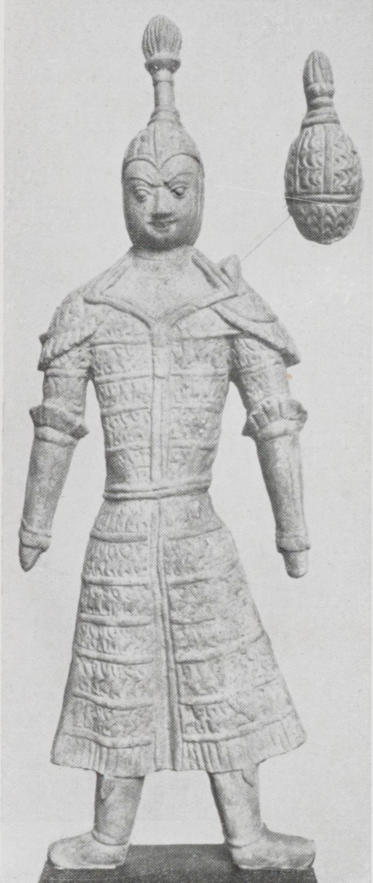Clay figure.
Armoured Cavalryman from Šōrčuq at Qarasahr.
8th Century(?)
 Source: fig. 67, p 59, Bilderatlas zur Kunst und Kulturgeschichte Mittel-Asiens : vol.1 by Albert von Le Coq |
 Source: fig. 67, p 59, Bilderatlas zur Kunst und Kulturgeschichte Mittel-Asiens : vol.1 by Albert von Le Coq |
Translated from the German:
fig. 67 Clay figure. Armoured cavalryman from Šōrčuq at Qarasahr. 8th Century. (?).
Later form of armour and helmet. The latter seems to be made of spangen and armour plates. The nasal is hinted. The armour has the defensive collar and special protective covers for the shoulders. It consists of platelets as shown in fig. 51. The forearms are armed with gloves (?); the feet are in boots, of a form found in Šōrčuq. The helmet has provision for the attachment of wings, we found the shapes for this in the same workshop. Museum for Ethnology.
fig. 67. Tonfigur. Gepanzerter Ritter aus Šōrčuq bei Qarasahr. 8. Jhdt. (?).
Spätere Form der Panzers u. Helms. Letzterer besteht anscheinend aus Spangen und Panzerplättchen. Die Nasenberge ist angedeutet. Der Panzer hat den Wehrkragen und besondere Schutzklappen für die Schultern. Er besteht aus Plättchen wie der in fig. 51 dargestellte. Die Unterarme sind mit Handschuhen (?) bewehrt; die Füße stecken in Stiefeln, aus einer in Šōrčuq gefundenen Form. Für den Helm sind an der Helmbrünne zu befestigende Flügel vorgesehen; wir fanden die Formen dazu in derselben Werkstatt. Museum f. Völkerkunde.
Referenced as figure 455 in The military technology of classical Islam by D Nicolle
455. Statuette from Sorcuk, 8th century AD, east Turkistānī, Museum für Völk., Staatliche Museen Dahlem, West Berlin (Coq).
See Khūd Helmets by David Nicolle, an extract from The military technology of classical Islam